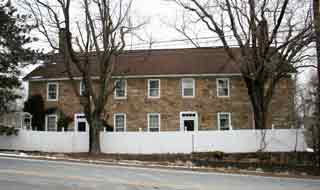
City and State: Lebanon, New Jersey
Listed: 1997
Type of district: National Register historic district, state historic district
Main Intersection: Cokesbury Road and Water Street
Cokesbury National Register Historic District Report
Cokesbury National Register Historic District Map
The Cokesbury Historic District is a residential village district that also includes churches and cemeteries, barns, and a number of buildings formerly commercial in nature that are now homes, including a hotel/tavern, general store, school, and wheelwright/blacksmith shop. The earliest building in the district, the former hotel, dates to 1812-13, when it was built to replace an earlier tavern destroyed by fire. Most of the buildings are vernacular in style, but they do incorporate certain elements of high style architecture popular at the time of construction, including arched windows of the Italianate, sidelights and transoms of the Greek Revival, and cross gables of the Gothic Revival.
Cokesbury is a typical rural village that developed to serve the local agricultural community. Although settlers had lived in the area since the mid 18th century, it was not until the Methodist congregation organized in 1814 that development of the village really began. The Methodist church, named in honor of bishop Dr. Thomas Coke and Bishop Francis Asbury, gave the village its name. The community grew slowly through 1850, with more rapid development through the 1870s. After this period, the village remained a social center but lost its economic and religious foundations as development moved to nearby villages with better access to modern transportation.
